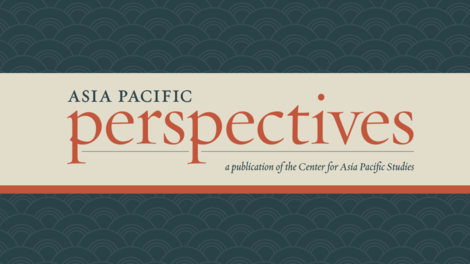
Volume XIV, No. 1: Fall 2016
Editor's Introduction

We are pleased to announce the publication of the Fall 2016 issue of Asia Pacific Perspectives. This special issue presents five papers focused on themes related to the social history of medicine and contemporary cultural understandings of disease and patients lived experiences in the Asia Pacific.
The idea for this issue originated with the planning for the University of San Francisco Center for Asia Pacific Studies’ fall 2015 conference, Bodies, Healing and Culture: A Social History of Medicine in East Asia. Inspired by the research presented at the conference and reminded of the benefits of scholars sharing research with one another beyond their particular area specialty, we decided to broaden our scope and time period to include the Asia Pacific from the past to the present and devote an entire issue to the topic.
Within this issue, you will find five papers that represent the diversity of topics currently being researched in the fields of medical history and contemporary studies in medical anthropology. These articles range in time from the 16th c. to the early 20th c. to the present. They also represent breadth in terms of topic — from the development of medicine as a profession and access to medical care, to cross-cultural exchange and encounters over issues linked to discourses on modernity such as birth control and domestic science, to patient narratives chronicling their responses to life-threatening diseases in contemporary Asia.
We begin the issue with Soyoung Suh’s study of surgical treatments of breast cancer in South Korea from 1959-1993. Suh begins her article by historicizing the discourse on breast ailments and notes records as early as the 1600s discussing the topic. In the 1930s, Suh notes how traditional treatments became replaced by surgical intervention as Korean medicine increasingly viewed Western medical techniques as superior. One of the highlights of Suh’s study is her discussion of the patient-physician relationship and patient’s family-physician relationship. The last section of Suh’s article is particularly poignant as it gives voice to the lived experiences of breast cancer patients and their attempts to negotiate a path to treatment and palliative care through surgery, activism and a search for alternatives.
Pamela Runestad’s article on narratives of people living with HIV/AIDS (yōseisha 陽性者) in Japan continues the theme of patients becoming active participants in the framing of their illness narratives. Combining field work among yōseisha participating in events such as the AIDS Bunka Forum and an examination of accounts of life with HIV/AIDS published by Place Tokyo, Runestad finds that yōseisha strive to achieve normalcy in their lives while also advocating for acceptance. Runestad argues that the utilization of ‘flexible kata’ (型 ), allows yōseisha to speak publicly about topics once considered taboo in Japan.
With Andrew Goble’s article we turn our focus to the development of medicine as a profession and women’s access to medical care in late 16th century Japan. Examining the Honganji Religious Community in Ōsaka and Kyoto through the diary of physician Yamashina Tokitsune, Goble adds to our understanding of medicine and community in pre-modern Japan. Chronicling the treatment of patients often over the course of years, Yamashina’s diary reveals a proactive attention to health, continuity of care, the complexity of medical prescriptions, and the ability of patients to receive access to care at practically all hours of the day and night. Goble’s section on Yamashina’s treatment of women during pregnancy is particularly interesting and provides important insight into female health support networks at the time.
In the next article, Mirela David uses the occasion of Margaret Sanger’s visit to China as a lens to study cross-cultural exchange regarding birth control during the 1920s. Sanger, an American birth-control activist and founder of Planned Parenthood, traveled to China in 1922 to lecture on the topic. While there, Sanger expressed her views that birth control could help solve China’s social problems caused by overpopulation and lack of resources and also help improve women’s health. During her visit she engaged with and stimulated discourse with Chinese journalists and intellectuals on the eugenic potential of birth control. By focusing on the translation of Euro-American discourses in China, David’s work adds to our understandings of eugenics in China and more broadly to the worldwide social movement and ideology.
In the final article, René Alexander Orquiza Jr. provides our readers with an understanding of the introduction and teaching of domestic science in the Philippines from 1906-1932. During this period, Orquiza finds that kitchens became classrooms that were designed to achieve widespread cultural change though the promotion of Western ideas of hygienic practices and healthier eating and expanded roles for Filipinas. Orquiza argues that in practice these classrooms and publications that promoted the teaching of domestic science in the Philippines created contradictions and reminded Filipinos of American cultural hegemony.
We end this issue with a book review by Eric Tagliacozzo of Robert Peckham’s edited volume, Empires of Panic: Epidemics and Colonial Anxieties.
On behalf of the journal and our authors, I would like to thank Dr. Leslie Woodhouse (Assistant Managing Editor) for the time, energy, and expertise she has put into bringing this issue to publication.
— Melissa S. Dale, Editor
